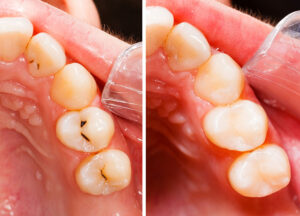Fillings
A dental filling is a body of restorative material designed and placed into a tooth to replace missing tooth substance and structure. The traditional material used to fill teeth, was amalgam which contained metallic elements and were of a silver or grey colour. Although amalgam is very functional and reliable often lasting decades, the material most commonly used today is that of a tooth coloured, metal free, composite resin. This material tends to look more natural, require less tooth preparation and is fully hardened by the end of the appointment.
Despite the advances in filling materials now available it is important to be guided by your dentist as to when a tooth can be restored by way of a filling. In instances where too much of the tooth has broken away or when a cavity extends deep and is close to the nerve other treatments such as a crown or a root canal filling may be the necessary.

Root Canal (Endodontics)
A process to alleviate the symptoms associated with the irreversible inflammation of the pulp (nerves) within the tooth. Teeth much like any other part of the body is innervated by nerves and blood supply. Unfortunately there are times when the nerve within the teeth can be irritated and inflamed beyond the body’s ability to self-repair. Common reasons as to why the nerve within the tooth may become inflamed include cavities allowing the penetration of bacteria, very deep fillings, traumatic injuries and cracks.
Over several visits the inflamed tissue is removed, the canals within the tooth are cleaned and then filled.
Once completed the tooth remains functional but will be devoid of sensation such as hot & cold sensitivity.




